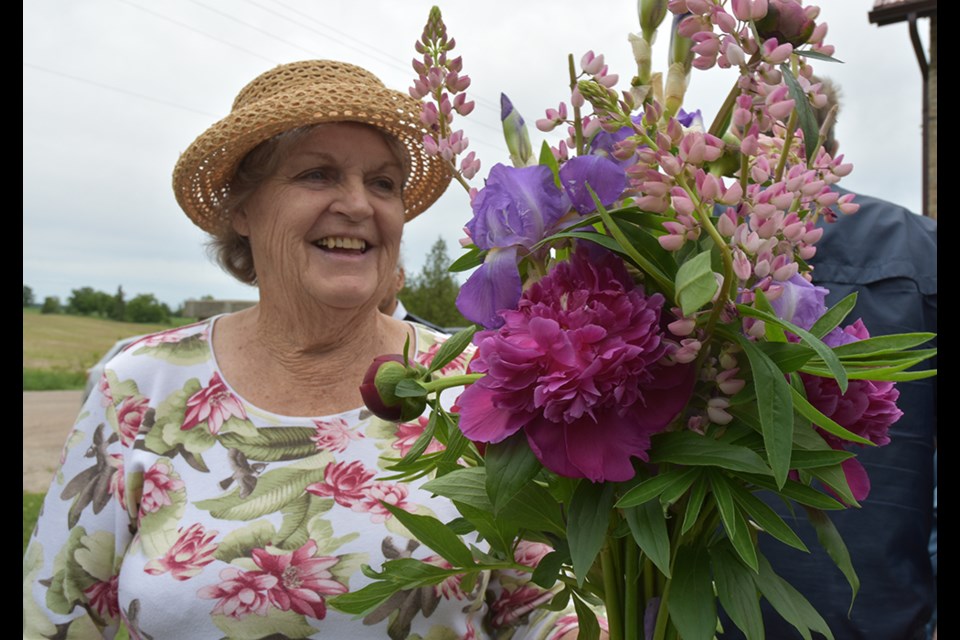Innisfil resident Paul Wardlaw stood beside the headstone of John Faris Sr. in the Auld Kirk Cemetery on the 6th Line of Bradford West Gwillimbury.
“This is my great-great-grandfather’s stone,” said Wardlaw.
Wardlaw was among the approximately 100 visitors who came out on Sunday to celebrate the 200th anniversary of the Scotch Settlement, and honour the intrepid settlers who came to West Gwillimbury after the township was surveyed in 1818.
The majority of those who took up land in the township in 1819 were of Scottish heritage, returning from Lord Selkirk’s Red River colony in Prince Rupert's Land after facing hardship, privation, disease, and the hostility of the North West Company.
There were also a handful of Irish families who settled in the area of the 4th, 5th and 6th Lines, including the Faris family.
On June 16, the Bradford West Gwillimbury Local History Association hosted the celebration marking the 200th anniversary.
Bagpiper James Harvey played, and piped the crowd into the Auld Kirk – a Church of Scotland (Presbyterian) church built in 1869 by the Scotch Settlement families, on land given by the Faris family. It replaced an earlier frame church and is now a designated heritage site.
Rev. Dan Scott, of St. John’s Presbyterian Church, was among the speakers. He congratulated the descendants of the Scotch settlers, noting the records show the first church on the site was opened for worship in January 1822, when 14 members received communion.
Bradford West Gwillimbury Mayor Rob Keffer spoke of the hardships faced by the Selkirk settlers, “so well-documented” in the records, and the Scots-Irish families who founded the community.
“It really hits home, the history that is so important,” Keffer said.
Although not a descendant, he currently farms the land that in 1850 was the homestead of Selkirk settler William Sutherland.
The event included musical interludes inside the church, self-directed tours of the historic cemetery, old-fashioned games and crafts for the children, and displays by the Bradford West Gwillimbury Local History Association. Several descendants of the Selkirk settlers brought family heirlooms and treasures to display, from a christening gown to a family bible.
“Family members are meeting family members for the very first time, and that’s wonderful,” said Bradford West Gwillimbury Local History Association member Mikki Nanowsky, who dressed in 19th-century garb to get into the spirit of the event.
Several of those who can trace their roots to the returning Red River settlers also spoke at the opening ceremony, including representatives of the Gunn, Sutherland and Bannerman families.
Jim Culbert, welcoming the visitors in Gaelic, was dressed as George Bannerman. George, born in 1793 in Kildonan, Scotland, was among the third wave of Red River settlers who followed Lord Selkirk to what is now Manitoba, only to leave and resettle in Upper Canada. Mary Bannerman, a descendant, was the grandmother of John Diefenbaker, the 13th prime minister of Canada.
Culbert noted the first order of business for the settlers was a “dwelling – not a 5,000-square-foot house, but two rooms,” heated by the same fire used for cooking. The second priority was clearing enough land to get a crop in the ground.
“The third thing was to build a church,” he said.
It was a different world.
“Everyone pitched in. The older children were in the fields before dawn and after school,” Culbert said, and the headstones in the cemetery illustrate the high child mortality rates, disease, and hardship faced by the settlers.
Ann Campbell, whose late husband Tom was a descendant of the Selkirk settlers, saluted “their guts, their grit, their determination… We hope that they’d be pleased and amazed that people, after 200 years, salute their courage and faith.”
A plaque was unveiled at the Auld Kirk, recording the names of those who have contributed greatly to the preservation of the historic structure: Eleanor (Sutherland) Reid, George Jackson, Ruby and Murray Faris, Josephine Wilcox Mills, and Vera Stoddart.
Cathy Reid, daughter of Eleanor Reid – a direct descendant of the Sutherlands who returned from the Red River – noted her mother founded the Scotch Settlement Historical Association to preserve the Auld Kirk, which was falling into “a state of disrepair.”
“My mother was a real Canadian, and wouldn’t the Red River settlers be proud to claim her as a real Selkirk daughter!” Reid said.
Ted Duncan, president of the Simcoe County Historical Association, called on all present to celebrate “the incredible strength and endurance of the first Scots settlers. They built a foundation of the community we see now… You should be thankful.”



